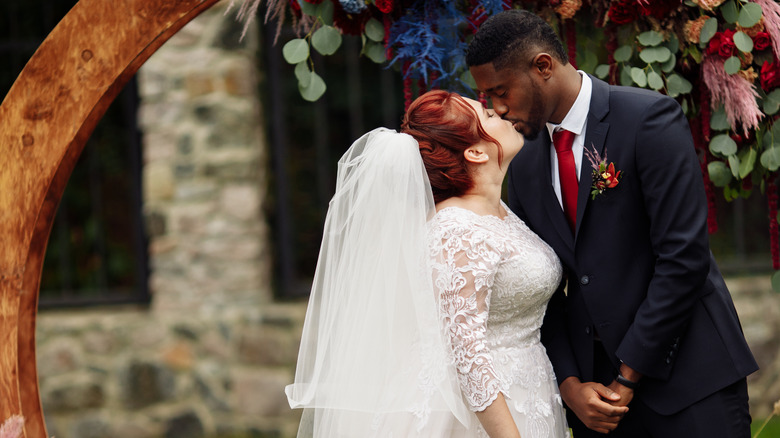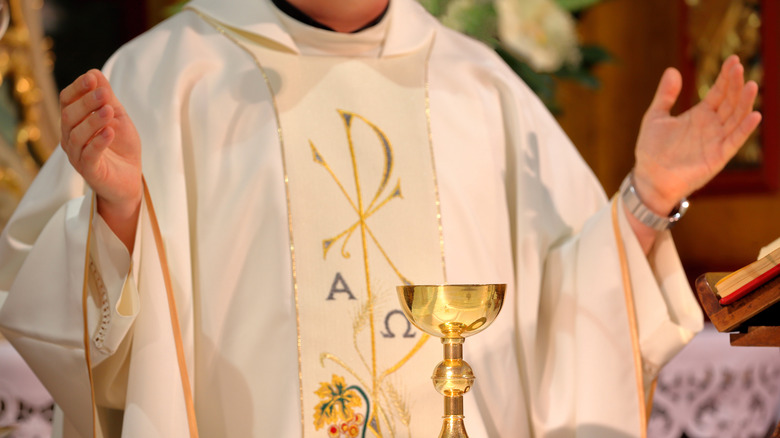Every Type Of Marriage Allowed In The Bible
The following article includes mention of sexual assault.
Many people around the world use the teachings of the Bible as a basis for how they life their lives, and the holy book covers a range of topics and behaviors, including marriage.
The Bible has references to marriages between widows and their brothers-in-law, marriages with slaves, relationships with concubines, and unions with prisoners of war. Some marriages in the Bible have also been interpreted as non-consensual. But the holy text has no mention of marriage between people of the same sex (the book has been interpreted as having a strong stance against homosexuality as a whole, although that is somewhat debatable). Today, there are many more forms of marriage than what is included in the Bible, including gay marriage and, depending on where you live, polygamous marriage.
Some of the marriages in the Bible were permitted, but are interpreted as not necessarily what God wanted for mankind. So, even though they are mentioned in the text, they're not necessarily the types of marriages that Christians are expected to take part in. Discover every type of marriage allowed in the Bible.
A husband and wife
The story of Adam and Eve is well known. Their relationship was designed by God, and it basically aligns with the later concept of the nuclear family, which is two parents of opposite genders and their children living together. In modern times, a nuclear family may include parents who identity as LGBTQ+, and the couple may not be legally married yet still choose to raise a family together, according to Love To Know.
Genesis 2:24 (via BibleRef) states "Therefore a man shall leave his father and his mother and hold fast to his wife, and they shall become one flesh." In other words, men must leave their parents and start a new life with their wife. God saw that man needed a companion so he would not be alone, and so created woman from man's rib, as per Genesis 2:22. The Bible deems that through marriage a man and woman are essentially creating a contract or covenant. Bible Ref explains that the two becoming "one flesh" indicates their sexual relationship as well as their familial one.
Polygamous marriage
Polygamy is the marriage of one man to more than one woman. Genesis 4:19 states: "Lamech married two women. The first was named Adah, and the second was Zillah." It's unclear whether polygamy started with Lamech, according to Bible Hub, but this reference is the first time that polygamy is mentioned in the Bible. Many prominent men in the Old Testament were polygamists, including Abraham, Jacob, David, and Solomon, according to Got Questions. Solomon alone had 700 wives as well as 300 concubines.
One theory is that God may have permitted polygamy so that women could have someone to take care of them at a time when single women had little power. Plus, it was a means of producing more children to populate the Earth. But, according to Got Questions, the Bible presents God's original plan to be one man married to one woman.
The Church of Jesus Christ of Latter-day Saints founder Joseph Smith reinstated polygamy in 1831, according to the Church. Various explanations have been offered as to why the Mormons adopted polygamy, including theories about it allowing the fledgling religious movement to more easily grow and it being the restitution of Old Testament practices. However, it's generally accepted that followers simply took Joseph Smith's words as direct from God, and that for reasons unknown to them, God wanted them to practice plural marriage. Today, the Church of Jesus Christ of Latter-day Saints prohibits the practice of polygamy, as it has done for over 120 years, although some fundamentalist Mormons continue to have multiple wives, as explained by The Conversation.
Marrying your brother-in-law: Levirate marriage
Genesis 38:6-10 states "For his first son Er, Judah got a wife whose name was Tamar. Er's conduct was evil, and it displeased the LORD, so the LORD killed him. Then Judah said to Er's brother Onan, 'Go and sleep with your brother's widow. Fulfil your obligation to her as her husband's brother, so that your brother may have descendants.'" (via Bible.com). This type of scenario was a set up for women who were widowed without any children. The practice of a woman marrying her dead husband's brother is known as a levirate marriage.
In Genesis, Onan refuses to get Tamar pregnant: "But Onan knew that the children would not belong to him, so whenever he had intercourse with his brother's widow, he let the semen spill on the ground, so that there would be no children for his brother. What he did displeased the LORD, and the LORD killed him also." According to Bible Odyssey, this type of marriage provided an opportunity for a man who died without biological children to pass on his name and property, but the real aim was to protect widows who didn't have anyone to take care of them following their husband's passing.
A man, a woman, and a female servant or slave
Genesis 16 describes the relationship between Sarai and Abram. Sarai was unable to have any children, so she allowed her husband to have sex with a female slave or servant named Hagar, according to Bible Gateway. The passage states: "And Sarai said unto Abram, Behold now, the Lord hath restrained me from bearing: I pray thee, go in unto my maid; it may be that I may obtain children by her. And Abram hearkened to the voice of Sarai."
Hagar was likely a slave that Abram received from the Pharaoh, according to Enduring Word. Sarai knew God had promised Abram that he would have several descendants, so she basically set up a surrogacy situation for her husband to have a child. Once the baby was born, Abram and Sarai would be considered the parents, not Abram and Hagar. After Hagar conceived, she fled to escape Sarah's cruelty. However, the Lord told her to return to her mistress. She did, and Hagar wound up having a son, who was named Ishmael.
At one point the Angel of the Lord said to Hagar, "I will multiply your descendants exceedingly, so that they shall not be counted for multitude." He was essentially telling her that her unborn son would have uncountable descendants, fulfilling the promise he had initially made to Abram.
A man, one or multiple wives, and concubines
Some men in the Bible had concubines in addition to one or more wives. The role of the concubine was to produce children if the man's wife was unable to do so, to have children to expand the family, and to take care of a man's sexual appetite, according to Christianity.com. While concubines had some rights under Hebrew law, they did not hold the same status as a wife. Concubines and polygamy were common during the "patriarchal period" of Abraham, Isaac, and Jacob, but in later Biblical times most marriages were monogamous.
Concubines were typically Hebrew girls sold by their fathers, gentile captives, foreign slaves, or Canaanite women. Free Hebrew women without other means were also sometimes concubines. Some scholars refer to Hagar, Sarai's servant, as a concubine, and Genesis 25:6 implies that a woman named Keturah was Abraham's concubine, according to Christianity.com. King Saul had a concubine named Rizpah, while King David had 10 concubines, and King Solomon had 300 concubines and 700 wives.
Bible Ref interprets Genesis 2:22-24 as saying that "men are to separate from their parents and stick to their wives, becoming one flesh with them." This can be interpreted as God wanting marriage to be between a single man and a single woman. Christianity.com explains that God's allowance of concubines can be interpreted as him helping women who were unable to provide for themselves, saying "Concubinage was not part of God's dream, but because human life now involved sin, God made laws to protect vulnerable women from further oppression, knowing a sinful world would always include broken relationships between men and women."
A male soldier and a female prisoner of war
Numbers 31:1-18 recounts how an ancient Israelite army killed all adult male Midianites during battle: "They warred against Midian, as the Lord commanded Moses, and killed every male" (via Biblia.com). Next, Moses ordered the murder of the captives, including male children. The only people who were allowed to live were virginal women. A small number of these women were made the slaves of priests. The rest were given to Israeli soldiers. "Now therefore, kill every male among the little ones, and kill every woman who has known man by lying with him. But all the young girls who have not known man by lying with him keep alive for yourselves," the text states.
According to Deuteronomy 21:11-14, these soldiers could choose any woman they were attracted to. Then, after a month had passed, and the woman had mourned the death of her family, God decreed: "You may go to her and be her husband and she shall be your wife. If you are not pleased with her, let her go wherever she wishes. You must not sell her or treat her as a slave, since you have dishonored her."
One interpretation of this text shared by Bible Hub states that these events "intimate how binding the laws of justice and honour are in marriage; which is a sacred engagement."
A man who has sex with an unmarried virgin
Deuteronomy 22:28-29 has been interpreted in more than one way. The passage reads: "If a man meets a virgin who is not betrothed, and seizes her and lies with her, and they are found, then the man who lay with her shall give to the father of the young woman fifty shekels of silver, and she shall be his wife, because he has violated her. He may not divorce her all his days." One interpretation is that a rape victim must marry her rapist, according to Got Questions. The words "seizes" is interpreted as rape, and the passage also notes that a man who has sex with an unbetrothed woman (whether it is consensual or not) must marry her.
If a woman was raped, she would be considered unworthy of marriage. Women without husbands had a very difficult time supporting themselves and often resorted to slavery or sex work to survive, according to Got Questions. The mention of the woman's father in Deuteronomy 22:28-29 is important. It was ultimately the father's decision whether or not his daughter should stay with the man who seized and violated her.
However, according to Apologetics Press, the translation from Hebrew to English notes that the word "seizes" can mean "lay hold on her" or "taking her," which don't necessarily indicate force. So, the passage may be interpreted as referring to a consensual coupling, not a rape.
If you or anyone you know has been a victim of sexual assault, help is available. Visit the Rape, Abuse & Incest National Network website or contact RAINN's National Helpline at 1-800-656-HOPE (4673).
Marriage between slaves
Theology of Work explains that slavery was not universally prohibited in the Bible. Although God rescued the Hebrews from bondage in Egypt, slavery was allowed in some situations, as long as the slaves were treated humanely.
Exodus 21:4 explains that a slave owner could allow one of his male slaves to take a female slave as his wife. The passage reads, "If his master gave him a wife while he was a slave and they had sons or daughters, then only the man will be free in the seventh year, but his wife and children will still belong to his master," according to Bible Hub. It's unclear whether the women involved had any say in the matter, so it's possible that rape was involved. However, Theology of Work explains that "if the buyer failed to treat the female slave with all the rights due an ordinary wife, he was required to set her free."
According to Religious Tolerance, during this time period, Israelite men were only required to be a slave for a limited period — as Exodus states, "only the man will be free in the seventh year" — while women were slaves for life. If two slaves married, when the male slave was released from servitude, the marriage would simply end. The wife would stay with her master alongside any children she produced with her slave husband. The husband, however, could choose to stay a slave to remain with his family.
What about gay marriage?
The Bible does not contain examples of same-sex marriage. However, it has been interpreted as presenting homosexuality as immoral, as explained by to Got Questions. Leviticus 18:22 states: "Thou shalt not lie with mankind, as with womankind: it is abomination." Romans 1:26–27 calls same-sex fraternizing "shameful" and "unnatural," while First Corinthians 6:9 labels homosexuals as "wrongdoers" who won't end up in the kingdom of God.
However, as M Live explains, there is ambiguity in the translation of the terms used in Corinthians, and some experts have more nuanced interpretations of the text. "Many scholars think that Paul is arguing against grown men having sex with adolescent boys and/or against men who are forced into the non-dominant position," explains Kelly Murphy, a biblical scholar (via M Live).
Every example of marriage included in the Bible includes a man and a woman and some expectation that the couple will raise a family together, in whatever form that takes. In 2021, Pope Francis reiterated his stance on gay marriage, saying: "Marriage is a sacrament. The church doesn't have the power to change sacraments. It's as our Lord established." (via Them). Earlier in that year, the Vatican released a statement that read: "There are absolutely no grounds for considering homosexual unions to be in any way similar or even remotely analogous to God's plan for marriage and family."
The head of the Catholic Church also made it clear that civil unions between same-sex couples should not include "things that by nature do not function in the church." However, the Pope did not condemn civil unions, and stated that members of the LGBTQ+ community are "our brothers and sisters."
Why can't Catholic priests get married?
Currently, Roman Catholic priests are not allowed to get married. However, that rule is based on tradition and not Catholic doctrine, according to Live Science. The main reason that priests are celibate is because it enables them to focus their energy on their parishioners and to live like Jesus, who did not have a wife. The Bible presents Jesus as an unmarried virgin who lives a life of chastity. As a result, many martyrs and church fathers emulated his lifestyle. But not everyone did.
Peter, who was the first head of the Catholic Church, was married. So were several apostles who lived during the time of Jesus. This practice changed during the Middle Ages, when priests started giving their sons preference when it came to positions within the fold. That's when the church banned priests from tying the knot and having children to inherit their positions. Spiritually, priests are a stand in for Christ, and as so they are celibate. According to Live Science, today people argue that celibacy is too challenging and keeps men from becoming priests.
It's worth noting that married Episcopal and Lutheran priests who convert to Roman Catholicism are permitted to be ordained. Also, men in the Eastern Rites can tie the knot before becoming ordained. In addition, a 2012 study found that a number of priests have had sexual relationships with either men or women.
As the tradition of priests being unmarried isn't rooted in theology, in theory the Pope could easily change the current situation and simply allow priests to marry without too much controversy about going against God's wishes.










